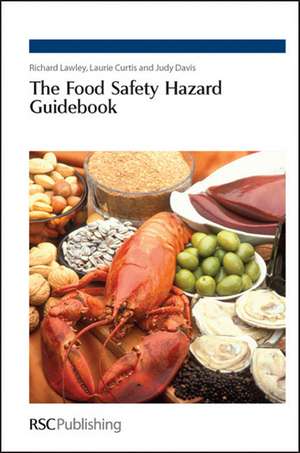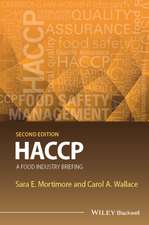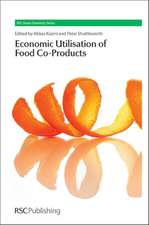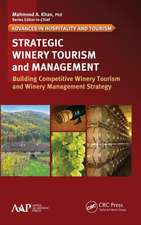The Food Safety Hazard Guidebook
Autor Richard Lawley, Laurie Curtis, Judy Davisen Limba Engleză Hardback – 31 aug 2008
Food safety is important and consumers have a right to expect that those who supply the food that they buy have taken every care to manufacture products that will do them no harm. Those with a responsibility for the regulation of the global food industry recognise this principle and legislate accordingly and the business of managing and regulating the safety of the food supply chain has come a long way in the last 25 years or so. Prompted by the emergence of new food safety hazards, such as the bacterial pathogens Listeria monocytogenes and E. coli O157, powerful new techniques for evaluating and managing the risks presented by these threats have been developed. For example, hazard analysis critical control point, or HACCP, has now become the food safety management system of choice worldwide. Although the food safety management tools are now widely available, they are still virtually useless unless they are supported by adequate and accurate information. HACCP does not work unless its practitioners have access to enough data and scientific knowledge to enable them to understand hazards and how to control them effectively. The Food Safety Hazard Guidebook is an attempt to address the problem of accessing the available information by distilling the key facts about a wide range of individual food safety hazards into a single text. The result is a guidebook, rather than an encyclopaedia, which acts as a portal for the immense and ever expanding body of scientific knowledge that exists for food safety. It is an easy-to-use information resource for anyone with a professional interest in the safety of the food supply. The book is easy to navigate and presents concise and carefully researched factual information on a wide range of biological and chemical hazards in a clear format that is designed to support risk analysis exercises and HACCP studies. It covers a broad range of established and emerging food safety hazards and includes details of authoritative sources of further information (many web-based) for those seeking to examine a topic in greater depth. The section on food allergens is a particularly valuable component of the book, the chapters on fish toxins are also useful and unusual in a book of this kind and bacterial pathogens are comprehensively covered. One of the most important features of the book is the wide scope of the content and the highly structured format designed to help the reader find information quickly. Other key benefits to the reader are: -The wide range of biological and chemical hazards covered in a single book -Written specifically with food industry professionals in mind -Easy to navigate and accessible for the non-expert -Clear and concise presentation of factual information presented in a format that lends itself to use in risk assessment exercises -Inclusion of references and web links to reliable sources of further information on each chapter -specifically designed for practical use by a professional readership
Preț: 578.92 lei
Preț vechi: 714.71 lei
-19% Nou
Puncte Express: 868
Preț estimativ în valută:
110.79€ • 120.30$ • 93.06£
110.79€ • 120.30$ • 93.06£
Carte tipărită la comandă
Livrare economică 18-30 aprilie
Preluare comenzi: 021 569.72.76
Specificații
ISBN-13: 9780854044603
ISBN-10: 0854044604
Pagini: 432
Dimensiuni: 155 x 234 x 28 mm
Greutate: 0.79 kg
Editura: Royal Society Of Chemistry
ISBN-10: 0854044604
Pagini: 432
Dimensiuni: 155 x 234 x 28 mm
Greutate: 0.79 kg
Editura: Royal Society Of Chemistry
Cuprins
Section 1: Chapter 1: Biological Hazards; Chapter 2: Bacteria; Chapter 3: Viruses; Chapter 4: Parasites; Chapter 5: Protozoa; Chapter 6: Nematodes; Chapter 7: Other parasites; Chapter 8: Prions; Section 2: Chapter 9: Chemical Hazards; Chapter 10: Biological toxins; Chapter 11: Fungal toxins; Chapter 12: Plant toxins; Chapter 13: Fish toxins; Chapter 14: Biogenic amines; Chapter 15: Non-biological chemical contaminants; Chapter 16: Contaminants produced during processing; Chapter 17: Contaminants from food contact materials; Chapter 18: Environmental contaminants; Chapter 19: Veterinary residues; Section 3: Chapter 20: Allergens; Chapter 21: Food allergy; Chapter 22: Specific allergens; Chapter 23: Allergen control options; Chapter 24: Allergen legislation; Chapter 25: Food Safety Legislation; Chapter 26: Sources of further information
Recenzii
In summary, this is a very useful reference book - and although it will not on its own enable food companies to deal with any particular hazard, it could well be a starting point from which it could build up a library of information.
Notă biografică
Richard Lawley is a food microbiologist and information specialist with over 25 years experience. He has worked in the food manufacturing industry, as a University Lecturer, and as a Senior Scientific Adviser at Leatherhead Food International. He now writes on food safety and technology issues and runs an independent information consultancy, Food Safety Info, and a related web site www.foodsafetywatch.com. Laurie Curtis has over 20 years experience as a microbiologist. She worked at Leatherhead Food International for over ten years, initially as a Senior Research Scientist and then as a Senior Scientific Adviser within the Information Division, specialising in food safety and microbiology. She now works as a part time freelance technical writer and information specialist. Trained as a biochemist, Judy Davis worked for some years in the pharmaceutical industry before joining Leatherhead Food International in 1993. As a Senior Scientific Adviser, she authored many technical reports covering research in food science, ingredients, health trends and food patents. She now works as a part time freelance technical writer and information specialist.
Textul de pe ultima copertă
The Food Safety Hazard Guidebook is an easy-to-use information resource for anyone with a professional interest in the safety of the food supply. The book is easy to navigate and presents concise and carefully researched factual information on a wide range of biological and chemical hazards in a clear format that is designed to support risk analysis exercises and HACCP studies. The Food Safety Hazard Guidebook covers a broad range of established and emerging food safety hazards and includes details of authoritative sources of further information (many web-based) for those seeking to examine a topic in greater depth. The section on food allergens is a particularly valuable component of the book, the chapters on fish toxins are also useful and unusual in a book of this kind and bacterial pathogens are comprehensively covered. One of the most important features of the book is the wide scope of the content and the highly structured format designed to help the reader find information quickly. Other key benefits to the reader are: -The wide range of biological and chemical hazards covered in a single book -Written specifically with food industry professionals in mind -Easy to navigate and accessible for the non-expert -Clear and concise presentation of factual information presented in a format that lends itself to use in risk assessment exercises -Inclusion of references and web links to reliable sources of further information on each chapter -specifically designed for practical use by a professional readership As regulation of food safety becomes ever more demanding, this book provides a much needed first port of call for food industry professionals and others needing clear information on specific food safety hazards and will become an indispensable resource for all food scientists.
Descriere
This book provides a concise, accessible and affordable source of reference covering a wide range of known and emerging food safety hazards, both biological and chemical.







